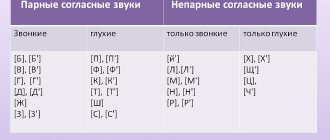To effectively work on the development of voice and speech, you need to understand what sound, voice and speech actually are. Therefore, the purpose of this lesson is to understand what sound, voice and speech are from the point of view of physics and anatomy. To achieve a positive result, you need to understand both aspects. Knowledge of anatomy will help you learn to control your voice , and understanding the physical foundations of sound will help you visualize the results of classes and control the correct sound production .
In this lesson we will look at the physics of sound, the physics and anatomy of the voice, and also learn how the voice works and what is common in the development of voice and speech. We will also provide links to useful services that will help you independently diagnose the capabilities of your voice, if you so desire.
We recommend doing this so that you can more easily and clearly see your progress once you start working with your voice.
So, we have a plan of action for the next lesson, so let's get down to business!
What is sound and voice from a physics point of view?
Let's start with what sound and voice are from a physics point of view. Sound is a physical phenomenon that is the propagation of mechanical wave vibrations .
From a physics point of view, sound has three properties :
- height;
- force;
- sound spectrum.
The height depends on the vibration frequency . Oscillations occur with a certain periodicity and are measured in hertz. Hertz is a unit of frequency for periodic processes in the International System of Units, as well as in the CGS and ICGSS units.
The strength of sound (aka volume) depends on the amplitude of vibrations . Greater amplitude means stronger sound. The unit of sound intensity is decibel (dB). For example: the rustling of leaves is about 10 dB, and a loud conversation is up to 90 dB.
The sound spectrum is a set of additional vibrations or overtones that arise along with the main frequency. This can be observed especially clearly in music or singing. Overtones increase the fundamental tone in multiple ratios (overtone: over, tone) and give the sound additional color, i.e. timbre.
Sounds with periodic (identical and evenly repeating) wave vibrations are called musical tones . Sound vibrations of non-periodic repetition are not musical tones. These are, for example, creaking, crackling and other sounds.
We will talk about the power of sound and sound spectra in the following lessons, but now let's return to the pitch of sound.
Types of sound by height:
- Wave vibrations perceived by the human ear, i.e. in the range of 16-20,000 Hz (hertz).
- Ultrasound is sound waves with frequencies higher than those perceived by the human ear, i.e. above 20,000 Hz.
- Infrasound is sound vibrations having frequencies lower than those perceived by the human ear, i.e. below 16 Hz.
Thus, the higher the vibration frequency, the higher the sound . In the context of our course on voice development, we are interested in the audible range, i.e. 16-20,000 Hz. In the lower part of the range, the sound is subjectively perceived as dull and bassy, in the upper part - as thinner and sonorous. The entire audible range of sounds is distributed along the so-called note-octave scale (see Fig. 1a), built on the basis of a binary system.
The fact is that sounds whose frequencies differ by 2 times (2 times higher or lower) are perceived by ear as similar. This table is well known to musicians, but it is presented to everyone else to understand how great the capabilities of human hearing and, accordingly, the voice are. You don’t have to delve into the designations of notes and octaves for now. We will touch on this topic when we talk about the development of the singing voice.
So we come to what voice is and how it differs from sound. Sound is a broader concept. In the context of our course, sound is absolutely everything we can hear . This is the singing of birds, the rustling of grass, the splash of water, the roar of a motor, the hum of a printer, the clink of glasses and, of course, the human voice.
The voice is the result of the work of the vocal apparatus and sound production organs (we will talk about their structure from an anatomical point of view later). The capabilities of the voice are somewhat less than the capabilities of the human ear, in the sense that even record holders cannot cover the entire gamut of sounds with their voices in the range of 16-20,000 Hz. True, some of them may go beyond the audible range.
Record-breaking voices from the Guinness Book of Records:
- The highest vocal note among men, “F sharp” of the 5th octave (5,989 Hz), was taken by Amirhossein Molai in Tehran (Iran) on July 31, 2021 [Guinness World Records, 2019].
- The highest note among women, “G” of the 7th octave (25,087 Hz), was taken by Brazilian singer Georgia Brown in 2004. Technically this note is not musical. Georgia Brown also holds the world record for the widest vocal range among women. Its range extends from the “G” of the major octave (98 Hz) to the “G” of the 7th octave (total 8 octaves) [Guinness World Records, 2004].
- The lowest vocal note among a woman was 57.9 Hz, which is slightly higher than the A note of the counteroctave. It was taken by Maryana Pavlova (UK) in Wallington, Greater London, UK, June 3, 2021 [Guinness World Records, 2019].
- The lowest vocal note produced by a man is G-7 (0.189 Hz), achieved by singer and songwriter Tim Storms (USA) at Citywalk Studios in Branson, Missouri, USA, on March 30, 2012. The frequency output of Timothy's voice was measured using Bruel & Kjaer equipment (low-frequency microphone, precision audio analyzer and post-analysis laptop) [Guinness World Records, 2012].
By the way, in music it is customary to use not the entire audible range. You can easily verify this by looking at the piano keys. All 88 keys (36 black and 52 white) cover the range from subcontractive A (27.5 Hz) to 5th octave C (4,186 Hz). This is completely sufficient to reproduce any piece of music that is comfortable for the human ear and the way we hear sounds.
You can check the capabilities of your own voice by downloading Pano Tuner and allowing the application access to the microphone. Try to play the highest and lowest note currently available to you, but do not do more than three attempts in a row, because this can lead to overstrain of the vocal apparatus. Record the result and repeat the experience after completing our course. If you have never trained your voice or worked on expanding your range before, you may be able to do so now that you have studied the anatomy of the voice and techniques that help with sound production.
There are options available online without first downloading apps. For example, the Vocal Max service. To start, click on the “Start” button, select the note that is most convenient for you to start with, and play it. As soon as you hit it, it will change color, and the next step will only be possible on any of the adjacent notes, both up and down. If you are not yet familiar with notes, try playing the note “C” of the 1st octave - it is in the range of almost every person. After studying the previous illustration, you can easily find it yourself.
As you play each of the subsequent notes, they will also change color. When you exhaust your range, click “Finish” and save the result, say, as a screenshot. Most likely, after 1-2 months of training, your range will become wider.
And finally, the speech. Speech is a joint result of the work of the vocal apparatus and thinking . If in order to make simple sounds (screaming, crying, moaning and others), we only need to use the vocal apparatus, for speech we need a preliminary understanding of what you want to say. For speech, a smaller vocal range is used than for various types of sounds - screaming, crying, moaning and others.
There is a distinction between internal and external speech, but in the context of our course we are interested, first of all, in the development of external speech, where the organs of sound production are involved. At the same time, beautiful external speech is impossible without the development of internal speech, i.e. planning and control “in the mind” of speech actions, internal pronunciation of planned phrases.
By the way, in our course you will learn that sound production can also be planned! “In your mind” you can rehearse not only the text of the future message, but also its emotional intensity, volume, and pitch. A meaningful approach to sound production, knowledge of the anatomy of the voice and an understanding of how certain movements and positions of the sound production organs affect your voice and your speech will help with this.
Voice resonators: sound amplification organs
The resonator helps increase the intensity of the sound wave. This organ creates a certain voice timbre and coloring. The upper resonators (head) form the sound, and the lower (chest) allow it to be transmitted correctly. The breakthrough of air provokes vibration of the ligaments - a sound appears. Such a sound attack of sound (hard, soft, aspirated) ensures the development of tactics for using the resource capabilities of sound production:
- A solid attack is characterized by air breakthrough and provides a smooth sound flow without jumps.
- A soft attack provokes ligamentous closure, which manifests itself during calm lyrical singing. Lullabies are performed in this manner: the sound “flows,” gently enveloping the listeners.
- The aspirate attack is used to achieve artistic expressiveness in the sound of the voice.
Using various tactics, you can achieve an effective sound and convey the most subtle intonations. Regular vocal lessons will improve your vocal skills and create your own performance style.
What is sound and voice in terms of anatomy?
Voice is a sound produced by exhaled air, vibration of the vocal cords and resonance. In this case, the vocal folds (or cords - we will use both terms) are involved only in fine control of the voice, and the main work is done by air flow and resonance.
To understand how the voice works and how speech is formed, we need to study the structure of the human sound apparatus. Let's divide the problem into two components: how the vocal apparatus works and how hearing works. Let's start with the voice.
General structure of the respiratory system and vocal apparatus:
| 1 | lungs; |
| 2 | rib cage; |
| 3 | diaphragm; |
| 4 | abdominal Press; |
| 5 | bronchi; |
| 6 | trachea; |
| 7 | larynx; |
| 8 | vocal cords (located inside the larynx); |
| 9 | pharynx; |
| 10 | oral cavity; |
| 11 | nasal cavity with accessory cavities; |
| 12 | elements of the nervous system that conduct and transmit signals connecting the vocal organs with the brain centers. |
We consider the respiratory system and vocal apparatus as a single whole, because sound production occurs due to exhaled air. We strongly recommend that you first study the structure of the respiratory system and vocal apparatus in the most general schematic form, and only then move on to a detailed study, analyzing illustrations with an increasing number of elements and details.
Here's a simple illustration:
Here's a more complicated one:
This approach will allow you not to get confused when studying sound production and voice formation, and to maintain a gradual transition from simple to complex.
Simple illustration:
And more complex:
Now let's move on to how exactly sound production occurs. Let's look at the process step by step.
Sound production - how it happens:
- Sound is produced by the flow of air exhaled from the lungs.
- The air stream moves the vocal folds.
- The pitch of the voice is determined by the length and tension of the ligaments. The stronger the tension, the higher the voice. The longer the vocal cords, the lower the voice.
- The strength of the voice is determined by the tightness of the ligaments and air pressure.
- The degree of tension on the vocal cords changes as the internal muscles of the larynx contract.
- The vocal cords are attached to the arytenoid cartilages and to the thyroid cartilages, the displacement of which determines the position of the ligaments.
- With the help of the tongue, lips, soft and hard palate, one or another shape of the oral cavity is created, which determines the production of one or another sound.
This is how the voice is formed:
And this is the speech:
Let us dwell in more detail on the dependence of voice pitch on ligaments . The pitch of the voice, i.e. the frequency of sound vibrations depends on both the voltage and the length of the vocal cords.
It is easier for short ligaments to vibrate, so they can perform a greater number of oscillations per unit time. The more vibrations, the higher the voice. Long ligaments are harder to “swing”, so they are capable of making fewer vibrations per unit time. The less hesitation, the lower the voice.
This phenomenon can be figuratively compared to the wingspan of birds. Thus, the wing beat speed of a miniature hummingbird ranges from 50 to 80, and in some species up to 200 beats per second. And such a noticeably larger bird like the stork makes only 2 (two!) wing beats per second.
Let us illustrate what has been said:
Looking at the diagram of the dependence of voice pitch on the length of the vocal cords, we can roughly say that basses are our storks, and sopranos are hummingbirds. This division, adopted in academic opera, is very arbitrary. There are people whose vocal range extends far beyond any one voice type.
For example, singer Dimash has a range of 6 octaves + 5 semitones from the “A” of the counter octave to the “D” note of the 5th octave. Thus, his voice fully accommodates the range in which baritone, tenor, alto and soprano sing, and also captures the upper part of the bass register and part of the so-called “whistle register”, which extends beyond the upper notes of the soprano. Having watched Dimash’s performance, you can hear how delicately he plays the notes of the composition’s melody (not to be confused with the lyrics of the song!) in the whistle register:
Here we come close to the difference between the formation of voice and the formation of speech. From the first part of our lesson, you already know that voice is a broader concept than speech . A voice without speech is possible - for example, screaming, moaning, crying, but speech without a voice is in no way possible.
The position of the tongue, lips, soft and hard palate plays an important role in the formation of speech . With their help, we create one or another shape of the oral cavity. This or that shape of the oral cavity allows you to direct the air flow in one direction or another, which determines the difference in sounds obtained with different positions of the tongue, lips, soft and hard palate.
Now a few words about where to direct the air flow. By default, the air flow is directed into resonators - cavities inside the body, reflected inside which it turns into sound. The main resonators for the human voice are the pharynx, oral and nasal cavities, and trachea . The paranasal sinuses, parietal bone, and other cavities inside the skull are also capable of resonating.
This, by the way, explains why we hear our own voice differently than the people listening to us. We perceive wave vibrations from the skull and other resonating cavities that pass through our body. Thus, we perceive the voice we emit not only through hearing. And all our listeners perceive our voice exclusively through their hearing. Therefore, if we want to find out how others hear our voice, we need to make an audio recording - for example, on a voice recorder in a smartphone.
Due to the fact that our course is of an applied nature, it would be appropriate to clarify a couple of points here. In most courses teaching public speaking, vocals, and speech technique, you will come across such a concept as a “chest resonator.” This is a certain convention due to the fact that it is difficult for the average person to imagine where his trachea is, but it is very easy to feel the vibrations inside the chest.
Therefore, if you want to expand the lower part of your vocal range, work on the beautiful sound of the low notes of your voice, you should be prepared for the fact that you will come across formulations like “working the chest resonator”, “exercises to develop the chest resonator”, etc.
Looking ahead, let's say that in lesson No. 2 we will touch on the topic of opening resonators, including the chest one, and explain the terms in more detail, so that in the future you can independently use any books and online resources on in-depth training in speech and/or vocal techniques.
So, resonators are natural amplifiers of our voice inside our body, allowing us to make our voice higher or lower, louder or quieter, and enrich the color of the timbre. Having learned to control the flow of air and direct it to one or another resonator, you will learn to control your voice as you see fit.
To understand what resonance is, you need to remember your youth - approximately the senior or middle group of kindergarten - when we blew on a piece of paper and received a real whistle. Or when they made a “telephone” from cups and string. The point is that the thread must be taut, and only then can sound be transmitted through it. By the way, you can reproduce this experiment now. At the same time, introduce the basics of physics to your children or nephews. Video instructions are attached:
By the way, note that at 01:25 an acoustic guitar comes into the frame. The sound of a guitar is also an example of resonance. Wave vibrations go through the soundboard hole into the body and are converted into sounds, the height of which depends on which string and on which fret you press. In this case, the strings are an analogue of the vocal cords. An electric guitar with a solid soundboard also has resonating cavities inside, they are just not visible from the outside. The electrical part only enhances the mechanical wave vibrations perceived by human hearing. And now we come close to the hearing device .
Features of the physiology of the vocal apparatus
The singer’s physiology and vocal cords are links in the same chain.
To learn to sing correctly, a person must unlearn to pay attention to vibrations in the throat, despite the fact that it is on the vocal cords that sound is born. The cords are the main element of the vocal apparatus. Their work determines what sound will come from: quiet or ringing, melodic or rough, rolling or compressed. The voice is a wave that is generated by the cords. It appears due to air pressure on the body when a person takes a breath. Vibrations are generated, the combination of which produces sound, and for singers these vibrations are so frequent and strong that the effect of singing is created. It turns out that “singing” is not a stream of melodic voice, but shaking the air and creating sound vibrations.
The effort with which a person creates vibrations determines their direction, which determines the flow that reproduces one of the many shades of singing. There will be no strength in the sound, if you do not send the voice forward, it will quickly fade away and dissolve in space.
The ligaments allow you to control the vocal flow because they have the ability to stretch and change shape. If a person sings loudly and high, then they become thin and long, if low, then they become dense and short. The closure of the ligaments is the final process when the sound leaves the throat. The mechanism can be studied and controlled, which is the task of an experienced teacher.
Hearing device
Hearing, voice and speech are closely interrelated. If, for example, hearing loss occurs in the pre-speech period, the person will never learn to speak. If there is residual hearing, a person can gain speech skills with the help of a hearing aid, which amplifies the sound enough to be heard.
How does hearing work?
- Outer ear.
- Middle ear.
- The eardrum between the outer and middle ear.
- Inner ear.
- Auditory pathways.
Here's a simple illustration:
And now more complicated:
Sound waves picked up by the outer ear strike the eardrum and cause it to vibrate. The vibrations are transmitted to the middle ear. In turn, the inner ear consists of two components. The first component is the vestibule and semicircular canals , which are responsible for the sense of balance and body position in space, which is why this element is often referred to as the “organ of balance.”
The second component of the inner ear is the so-called cochlea , filled with fluid that vibrates under the influence of wave vibrations. Inside the cochlea there is a special organ (the organ of Corti), which is directly responsible for hearing. It contains about 30 thousand cells that capture sound vibrations and transmit the signal to the auditory zone of the cerebral cortex. Each cell is tuned to a certain frequency, and if some of them die, the person will stop hearing sounds at the frequency for which the dead cells were responsible.
It is also worth talking in more detail about auditory pathways . This is a group of nerve fibers responsible for transmitting nerve impulses from the cochlea to the auditory centers located in the temporal lobes of the brain. Complex sounds (speech, melody, song) are processed and analyzed in the brain. The speed of transmission of an audio signal from the outer ear to the centers of the brain occurs in 10 milliseconds.
An idea of how hearing works, how we hear sounds allows us to better understand what an ear for music is and how to develop it. Most of us have heard the expression that “non-functioning organs atrophy.” This fully applies to the elements of human hearing.
The more cells you make out of those 30 thousand that pick up sound vibrations and transmit the signal to the auditory zone of the cerebral cortex, the more trained your hearing will be. If you listen to sounds at different frequencies, over time you will train every cell of the organ of Corti. They will begin to respond faster to “their” frequency.
Accordingly, the nerve fibers that are responsible for transmitting nerve impulses from the cochlea to the auditory centers will quickly transmit the most accurate information to the auditory centers located in the temporal lobes of the brain. And the processing and analysis of complex sounds will become more detailed and effective each time.
We recommend that everyone who is interested read the article on our website “Musical ear: what is it and how to develop it.” If you are a professional musician, much of the information will be known to you. But if you are not familiar with musical literacy, but are planning a career as a lecturer, speaker, tribune, teacher, psychologist, you should read the article and take some elements of the development of musical ear into service, because this will help you in the further development of your voice and speech after completing our course.
Now let's summarize the lesson. Today you studied the physics of sound, the physics and anatomy of the voice, and also learned how the voice works and what is common in the development of voice and speech. You learned that the main physical characteristics of sound are height, strength and sound spectrum , and you also became acquainted with the structure of the vocal apparatus, hearing organs and understood how sound production and voice formation occur.
Consolidate your acquired knowledge with a test, after which we are waiting for you in the next lesson!
Vocal errors when working with ligaments
In order for a person to sing, the process must proceed as described in the description above.
If for some reason one of the stages is skipped, the person will not hear a beautiful voice at the exit. Control problems arise when vocal breathing is established. If you take too much air into your lungs, the ligaments will not close. An equally common mistake is saving air. Experts call this a voice clamp. When a person sings loudly, the closure of the ligaments is tight, when it is quiet, the closure is moderate. This action is provided by the muscles of the larynx. This part of the vocal apparatus has cartilages, which are responsible for controlling the vocal muscles. Without inhalation, the singer will not be able to control the ligaments. They work strictly in a chain. The main levers of singing are exhalation and the muscles of the larynx.
Additional information from voice physiology A person is unique, just like his voice. Scientists have found that there are no two people on earth who have it identical. Professionals can fake other people's voices, but it is impossible to get an exact copy from birth.
Other interesting facts:
- Men have longer ligaments, which is why their voice is rougher.
- The similarity of voices among relatives is genetic.
- Only vocal exercises can increase the mobility of the ligaments.
- When a person speaks, only a small part of his range is used.
You can break glass with your voice if you learn to expand your range. There are cases in history when a girl was able to shout over the sound of an airplane engine on the runway. The low range starts at 100 Hz, and the high range starts at 2000 Hz.
Speech apparatus and defects
The degree of development of the speech apparatus determines the quality of pronunciation of sounds. Diseases of any of the departments are manifested by a deterioration in sound pronunciation and change the characteristics of a person’s voice. The task of speech therapists and doctors when identifying phoniatric symptoms is to identify the causes of their occurrence and select methods to eliminate the defects.
Due to the complexity of the structure of the speech apparatus, there are many possible causes of impaired sound pronunciation. Diagnostic measures should always be comprehensive and selected individually for each person. There are several reasons for the development of speech defects, which occur most often:
- organic disturbances in the structure of individual structures;
- their functional immaturity, which causes incorrect movements during the conversation;
- neurological disorders in those parts of the central and peripheral nervous system that are involved in the formation and formation of sounds.
With these defects, a person often notices problems with breathing, swallowing food and liquids. Such symptoms gradually lead to a decrease in the level of quality of life and can cause impaired adaptation in society, depression and other negative consequences. If you have delayed speech development or other defects, you should always seek professional help from doctors or a speech therapist. Specialists will conduct the necessary examinations and select corrective measures to eliminate the organic or functional defect.
The human vocal apparatus has a complex structure and consists of three main parts: respiratory, vocal and articulatory, or sound-pronouncing. All structural departments act in concert, determining not only a person’s voice, but also the formation and pronunciation of all sounds and words. The regulation of the speech process is carried out by the central nervous system, namely the cerebral cortex, subcortical extrapyramidal systems and the nuclei of the cranial nerves. Knowledge of anatomy allows you to promptly identify changes in the speech organs, primarily located in the oral cavity.











